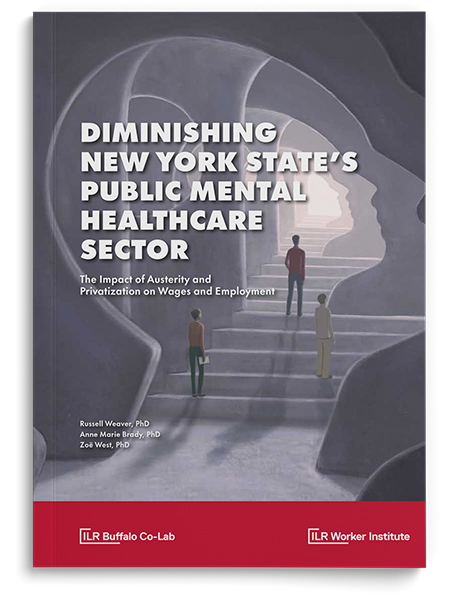
January 9, 2025 — One of the cornerstones of PEF’s Fund Our Future campaign is privatization and how it is detrimental to the public interest.
New York closed more than 2,000 state-operated inpatient mental health beds during the Cuomo administration, and as a result was woefully unprepared to deal with mental health needs during and after the COVID pandemic.
PEF partnered with researchers at the Worker Institute and the Buffalo Co-Lab at Cornell University’s School of Industrial and Labor Relations (ILR) to conduct a study on the impact of austerity and privatization, focusing on the mental health sector.
Researchers investigated changes in the size of the mental health workforce; changes in the composition of that workforce; changes in the overall wages of workers in mental health–related industries; wage changes in those related industries relative to comparison industries; and wages by employer type (private sector vs. state government) for top occupations in related industries.
Key findings
While employment in key mental health–related industries—psychiatric hospitals and residential care facilities—is trending upward, all growth has been concentrated in the private sector. Between 1990 and 2021, the number of jobs in these industries increased almost seven times faster than job growth observed in New York State’s economy, but the number of jobs in state government–owned mental health facilities has fallen precipitously over time.
“Public sector jobs in mental health industries have traditionally paid significantly higher wages than the same jobs in the private sector,” said Anne Marie Brady, the Senior Extension Associate – Research Director, Worker Rights and Equity, at the ILR Worker Institute. “Unionization is presumably one of the key reasons for these wage disparities. As mental health work shifts more toward the private sector, mental health workers stand to see their purchasing power decrease.”
The Cornell report found that in 2020 the median annual salary of a full-time worker in the mental health industry was more than $1,700 greater in the public sector than the private. The wage differential was even higher for traditionally working-class occupations, like cleaning staff, secretaries, and aides.
The study concluded that policies adopted by the state slashed budgets, closed facilities and beds, and shifted resources from the state to the private sector. In 2021, PEF fought attempts to curtail services at Buffalo Children’s Psychiatric hospital by 50% and to close the Rockland Children’s Psychiatric Center. If it wasn’t for the advocacy of unions like PEF saving critical institutions, even more mentally ill New Yorkers who need a higher level of care would be left walking the streets.
“Policy reforms have left New York’s mental healthcare system reliant on private, non-profit providers of community-based care and general hospitals – both private non-profit and public safety net hospitals – with significantly reduced capacity for inpatient psychiatric care,” Brady said.
The study also showed declining government employment opportunities have disproportionately affected women and workers of color.
“Crucially, the shrinking levels of state government employment in mental health-related industries do not appear to be race- and gender-neutral,” Brady said. From 2000 to 2020, the largest drop in the MH-related state government workforce occurred among African American workers, with African American men experiencing the largest relative drop.
Mental healthcare capacity on the state government side has contracted considerably, Brady said.
“Just 20 of the state’s 62 counties experienced increases in psychiatric care capacity, measured by the number of providers per 100,000 residents,” she said. “Most counties (40 of 62) saw their capacity decrease. That contraction is a statewide phenomenon, though the heaviest losses are occurring downstate.”
The diminished capacity has had negative impacts.
“The majority of counties (34 of 59) experienced increases in age-adjusted suicide rates over [roughly] the past decade.” Brady said. “These findings reinforce the emerging picture that at least one indicator of population-level mental health in New York State (suicide) has, on balance, been stagnant or worsening in the last decade.”
Brady said the bottom line is clear: “Trends toward privatization and state government austerity in the New York State mental health workforce are costing New Yorkers good paying union jobs, and the good jobs being lost have been disproportionately held by women and African Americans.
What will PEF do with the study results?
“With this research we will make a case to legislators that privatization is not good for anybody — patients, their families, workers and communities,” said PEF Vice President Randi DiAntonio, who has worked for decades as a Licensed Master Social Worker at the Office for People with Developmental Disabilities. “It’s really tied into our overarching goal of rebuilding not only the state workforce, but also mental health services. Presenting this information at conferences and to various state officials, we believe will help us be better advocate for what we need.”
The Hochul administration has made efforts to improve state-operated bed capacity but more needs to be done. In 2022, the state invested $27.5 million to support increased reimbursement rates for inpatient psychiatric beds, but in 2023, 850 beds remained offline.
“Even with additional resources, it’s clear the private provider network does not have the financial incentive to address the needs of New Yorkers,” said DiAntonio. “They simply aren’t accountable. This critical shortage has now lasted years, and it’s time for a change. Reinvest in State mental health staffing and services so New Yorkers can receive the care they deserve.”
Click here for the complete Cornell report.
Editor’s Note: DiAntonio and PEF President Wayne Spence are part of a virtual panel discussing the report on Feb. 6 from 10-11:30 a.m. PEF members may register, here.

